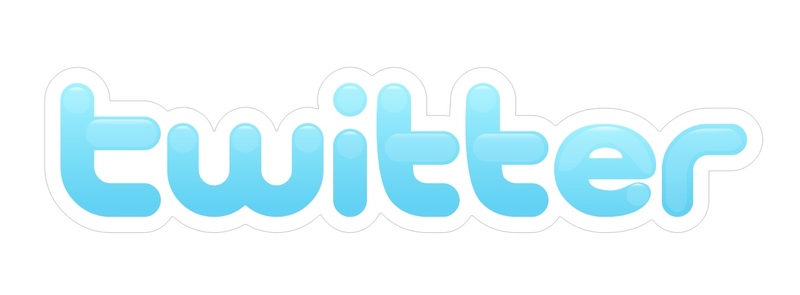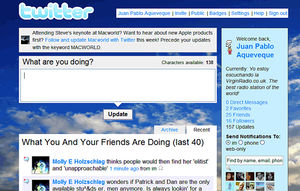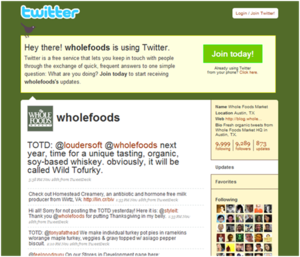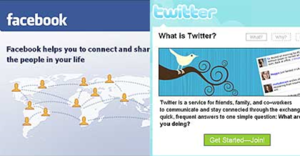Twitter- Next Facebook or Fad?
By Matthew, Ricky, Justin, Annie, and Stephanie
Twitter was created in 2006 by Jack Dorsey, Evan Williams and Biz Stone it hopes that it might one day be the next big social networking and micro blogging website and rival Facebook and MySpace the largest websites of its kind. Twitter does not have as many applications and functions as Facebook but it is much simpler to use and is better for people who are not as comfortable with computers and for people who just want to see what their friends and family are up to without having to sort through all the pictures, messages and walls that Facebook comes with. Today Twitter is at the peak of its popularity and is gaining recognition across the world from bloggers, large companies who now have Twitter applications and everyday people across the world. Twitter isn’t only being used to check up on other peoples status’s but is also being used to raise awareness about humanitarian issues, politics and many large companies are using it for advertising. Although Twitter has many bright upsides privacy and security has become a huge concern for many of Twitters users and potential users. Some people are unsure if they should sign up for Twitter because it shares all the personal information you give it with third parties, which makes many people nervous about sharing personal information with Twitter. Since Twitter was first started it has been rapidly gaining popularity across the world and some people are even comparing it with Facebook, others say it will never reach the size and popularity of Facebook. Is Twitter really the next Facebook or is it just a fad?
Contents
History
Twitter was a project originally designed for a pod casting service, Odeo, by a man named Jack Dorsey. Jack Dorsey started with the idea “What if you could share your status with all your friends really easily, so they now what you’re doing? But you don’t want to have to write a whole blog entry or LiveJournal entry.” March 2006, This idea was then shown to Odeo with the addition of text messaging, was recognized immediately.
About five month after, Twitter was launched. At first, it was Twttr.com because Twitter.com was owned, so it was half-launched. By August 2006, signs of growth started to reflect.
Twitter noticed an increasing percentage ( up to 30%) of the users are from Japan even though Twitter service is in English. In April 2008, a Japanese version of Twitter was launched with Digital Garage. The partnership agreement with Digital Garage consist of advertisement in Japan.
Uses
Personal
Twitter started out as a way to connect people more closely by giving them a method to share the big and little things that happened in their lives. Twitter members receive feeds from the people they are subscribed to such and friends and family and in turn post “Tweets” telling those subscribed to them about what has happened in their day or anything else that interests them. This, according to Twitter, makes it a better way to stay in contact with people you don’t see on a regular basis, compared to regular blogging. They argue that through Twitter people hear about the big events in your life but also the small ones that would be otherwise overlooked.
Political
Twitter’s political applications were displayed during the Presidential Election. Both John McCain and Barack Obama have pages which they updated regularly during their campaigns. They were used for the most part to post links to speeches or advertise upcoming appearances. McCain has just under 5000 followers on Twitter while Obama has over 135 000. However, by comparison, Obama has over 3.2 million supporters on Facebook. Twitter was also used by individuals to broadcast their political opinions during the campaign. Twitter use went up 43% on Election Day. During the Canadian election CBC followed activity on Twitter in relation to what had been happening at the same time. For example, they noted increased activity during the Leader’s debates and the Leader’s speeches after the winners had been announced.
Businesses
Businesses are starting to see the value of Twitter as a new marketing tool. They can create their own page and use it to tell those interested about promotions, link to related articles or websites, or many other things. As well, they can use Twitter to track people’s opinion of their or their competitor’s businesses and even talk to those with complaints. Whole Foods, for example, an organic grocery store chain in the US, has a promotion called Tweet of the Day where they give a $25 gift card to the person who has the Tweet that best advertises them. Whole Foods also announces special deals on Twitter and have conversations with those who complain about an aspect of their company on the site.
Other Organizations
Many civil services and NGOs (Non Governmental Organizations) are also starting to use Twitter to get important information out. The Los Angeles Fire Department uses Twitter to send out information about fires in progress, including the locations and how many firefighters are involved. Colleges and Universities such as the College of Engineering in San Antonio use Twitter to get out information students may need, from special events to security announcements. A recent study published in the New Scientist magazine found that “social media” tools did a better job of getting out information such as school shootings and the spread of wildfires than conventional news media or governmental services. NGOs such as the American Red Cross and World Vision use Twitter to get up to date information about emergencies to those who would like to know as well as promoting their causes.
Security
Twitter Privacy Options
Not everyone wants the rest of the world to be able to read what they say, whether it be their boss or their parents. Twitter gives you the option to lock your profile, allowing only people you approve of to view your updates. This is a good security feature that has been put in place to prevent people form finding out your personal information. This is supposed to keep your tweets private so not everyone can see them but sometimes information leaks out, so if you really don't want to take the risk of having other people see your tweets, don’t Twitter it.
Twitter Profile
If you enter items into Twitter, they can be private, so only friends you've authorized can see them, or public, which means anyone who knows your Twitter ID will be able to read and subscribe to them. This is a good thing because then you can choose whether to share your tweets with everyone or only have a select group of people see them. This can help stop your private information from leaking out. If you select the "Protect my updates" box, people won't be able to read your Twitters unless you authorize them. To find a user page, use the search box on your own Twitter page. Once you click "add," if the user's account is set to allow public access, you'll start to see his or her tweets on your page. If he or she is private, the system will send a friend request that must be approved before you start to see updates. This way you can stop random people from adding you and seeing all your posts.
Privacy Policy
Twitter collects personal information about its users and shares it with third parties. Twitter reserves the right to sell it if the company changes hands. This could pose many security issues because all the information about a person is kept on record so if someone was to gain access to that record personal information could be leaked.
An army intelligence report identified the Twitter as a potential terrorist tool. The report said, "Twitter is already used by some members to post and/or support extremist ideologies and perspectives."
Privacy Settings
Another risk with Twitter is that because it allows people to see what you are doing it would be an easy way for someone to find out if you are out of town. This can pose a risk if you don’t have your privacy setting set up properly because if not, everyone can see that your are out of town so it can let a stalker or robber know this information.
Disadvantages Within Twitter's Security and Privacy
The Third Party System
A major disadvantage in the protection of users is in how Twitter utilizes a third party system. This is a system in which they relay private information to separate organizations in order for such groups to perform functions and provide service to them. Private information of its users is disclosed to such third parties, which is necessary for Twitter to connect and function with them. This allows Twitter to be used on many different devices, such as Macs, PCs, phones etc., and with many unique applications such as a Windows Vista Desktop Sidebar Gadget that helps you keep track of all "sweet tweets" by fetching tweets from twitter.com and updating them every 10 seconds and many others. Therefore this interaction with separate third party groups makes Twitter more versatile and efficient.
However the transferring of personal information may leave ones private information vulnerable, because other programs may become more susceptible to hacking, as other systems may have weaker security than others. Ones personal information including, their IP address, email address, city, telephone number, password and other private information may be transferred to such providers. Therefore if one is able to obtain such information from third party providers, users of Twitter may be at risk, as their private information may be used to access their accounts, locate and contact them. This leads to the possibility of users getting their accounts taken over, which can be used to tarnish their name or humiliate the person and even spread viruses. It can also lead to harassment, stalking and many other crimes as they also have access to information such as ones phone number and address.
Thus Twitter is locked in a struggle between the efficiency and versatility of the program, versus its security and privacy. This is a very difficult scale to balance, as to be completely secure is to be totally cut off and disconnected from the world, thus removing the main purpose of this program. From that, Twitter leans towards efficiency and versatility of the program over its safety, allowing it to connect more people openly and easily, which distinguishes Twitter from many other programs with similar mandates, thus making it the unique and powerful program that it is.
The Facebook Comparison
Since it was first created in February of 2004 Facebook has become the most widely used social networking website in the world with nearly every teenager and young adult using it. Following Facebook’s enormous success many others have tried to create a similar website in hope that it will rival Facebook and experience the same success that Facebook has in the past four years. So far no website has even come close to challenging Facebook as the number one social networking website but Twitter has started to earn recognition across the world as an exceptionally popular social networking website that has been growing rapidly in the past two years. Although Twitter has not yet reached the immense size and popularity that Facebook has, it continues to grow and many people are starting to consider Twitter to be the next Facebook. In September of 2008 Facebook was estimated to have over 120 million active users while Twitter was estimated to have 3 million but Twitter is increasing at a much more rapid rate then Facebook and the number of visitors to Twitter was increased five times in just the month of September. Twitter was designed to have many similarities to Facebook but still keeping some very important differences that keep in unique and attract many users that Facebook fails to attract. Facebook is designed to attract teenagers and young adults, who use Facebook to share pictures, chat instantly, send messages, and keep friends and family updated by creating personal status and many other similar features. Twitter’s targeted users are a similar age group but is also designed to include a slightly older genre because it is designed to be easier to use then Facebook so that even people who are not very comfortable using computers can still easily use Twitter. The largest genre of users that Twitter attracts today is the bloggers who have become a surprisingly large population lately. Unlike Facebook, Twitter does not allow you to share pictures or use functions that Facebook has such as honesty box and a wall. Twitter simply asks one question, “What are you doing?” By asking just this one question Twitter makes it easy for users to update what they are doing and see what other loved ones and friends are doing. Through this one question most people discover several things about people they think they know really well, that they never knew before. Like Facebook, Twitter allows you to control who is able to see your updates and whose updates you are able to see. Twitter also has mobile applications like Facebook does, where you are able to receive updates on your phone but one exceptionally interesting function that Twitter has, is that you are able to switch off you updates so that you won’t be bothered by constantly receiving updates during a meeting, supper, etc. Based on the way that Twitter is designed it doesn’t seem likely that it will ever overtake Facebook as the top social networking website. The functions and applications that Facebook has that Twitter does not make it seem very highly unlikely that Twitter will ever become more popular especially because it is mainly teenagers and young adults who use social networking websites and these type of people will more than likely find that just constantly seeing peoples updates on what they are doing boring compared to looking and commenting on pictures, watching videos and writing on walls like you can on Facebook.
Conclusion
Twitter is gaining popularity across the world with more and more people using it every day but it is still nowhere near the size and popularity of Facebook and it seems highly unlikely that it will ever catch it. Of all Twitter’s upsides that have made it so popular around the world, there are still some glaring negatives to using Twitter. The largest of these negatives is the security and privacy issues that come with using Twitter. Many people are beginning to ask the question “Is Twitter the next Facebook or is it just a fad?” For now it seems that it is not the next Facebook at least until it solves some of its privacy and security issues and makes some changes to make it more appealing to the typical social networking user, but Twitter will most likely continue to grow instead of just being a fad.
References
Matthew
http://www.buzzblogger.com/a-comprehensive-guide-to-twitter/
http://en.wikipedia.org/wiki/Twitter
http://en.wikipedia.org/wiki/Facebook
http://twitter.com/about#about
http://www.facebook.com/facebook
http://www.time.com/time/business/article/0,8599,1603637,00.html
http://net.educause.edu/ir/library/pdf/ELI7027.pdf
http://www.facebook.com/press/info.php?statistics
http://news.google.ca/news?hl=en&q=about+facebook&um=1&ie=UTF-8&sa=X&oi=news_group&resnum=4&ct=title
Annie
http://www.pbs.org/mediashift/2007/05/twitter-founders-thrive-on-micro-blogging-constraints137.html
http://www.nytimes.com/2008/10/21/technology/start-ups/21twitter.html?_r=2
http://www.readwriteweb.com/archives/twitter_japan.php
http://blog.wired.com/business/2007/04/flickr_document.html
Stephanie
http://www.azcentral.com/community/chandler/articles/2008/08/27/20080827abrk-twitter0828.html
http://technology.inc.com/networking/articles/200809/twitter.html
http://twitter.com/BarackObama
http://www.tvweek.com/news/2008/11/cnn_msnbc_web_sites_most_popul.php
http://twitter.com/engineeringutsa
http://twitter.com/gtcomputing
http://www.informationweek.com/blog/main/archives/2007/10/google_maps_and.html
Justin
http://michaelmartine.com/2008/11/05/beginners-guide-twitter/
http://m.cnet.com.au/software/339274342.htm
http://en.wikipedia.org/wiki/Twitter#Privacy
http://www.theprivacyblog.com/?p=16
http://www.tothepc.com/archives/new-twitter-privacy-features-birdie-gets-little-private/
http://www.itbusiness.ca/it/client/en/home/News.asp?id=49410
http://valleywag.com/5068550/twitter-bug-reveals-private-messages
Ricky
http://www.techcrunch.com/2008/11/30/facebook-google-myspace-data/
http://twitter.pbwiki.com/Apps
http://twitter.pbwiki.com/Ideas
http://brianshaler.com/blog/2008/11/23/twitter-security-issue/
http://www.techcrunch.com/2008/04/23/privacy-disaster-at-twitter-direct-messages-exposed/
http://news.cnet.com/8301-1009_3-10007323-83.html
http://zackfasel.com/blog/?p=13
http://www.betanews.com/article/GroupTweet_to_blame_for_Twitter_security_compromise/1208990445



